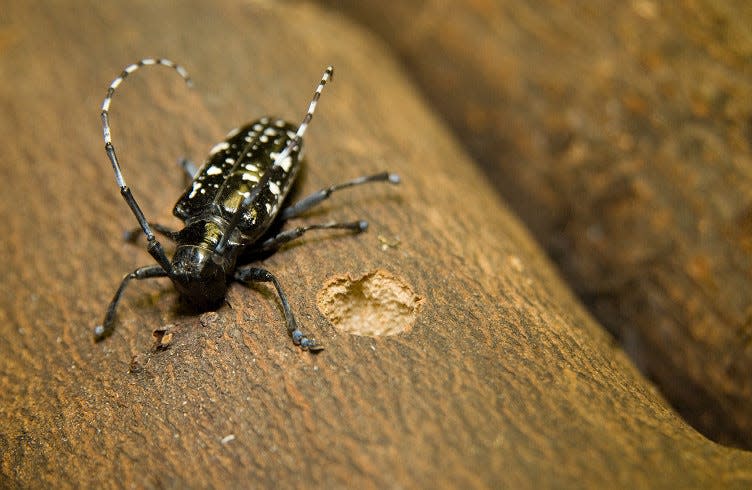'If you take a walk, take a look': USDA wants Ohioans to help eliminate this pesky insect
The U.S. Department of Agriculture (USDA) wants you to watch out for an invasive species this month.
Ohio residents, particularly in Clermont County, should check their trees for the Asian longhorned beetle during August, National Tree Check Month, the USDA requests. According to a press release, individuals are most likely to spot adult beetles during August, making it an essential time of year to look for the insect.
“You can help us protect more trees and eliminate the beetle from the United States. If you take a walk, take a look,” said Josie Ryan, Animal and Plant Health Inspection Service operations manager, in a statement. “The sooner we spot the beetle, the sooner we can help stop its spread.”
Here's what you should know about the Asian longhorned beetle.
What is an Asian longhorned beetle?

The Asian longhorned beetle is an invasive, wood-boring beetle that attacks 12 types of hardwood trees in North America, including maple, elm, buckeye, birch and willow trees.
The adult beetle has distinctive markings that are easy to recognize. Here's what you should look for:
A shiny black body with white spots about 1-1 ½ inches long.
Black and white antennae that are longer than the insect’s body.
Six legs and feet that can appear bluish.
What to know about infested trees
In its larval stage, the Asian longhorned beetle feeds inside tree trunks and branches, creating tunnels. Adult beetles then chew their way out of the tree during warmer months, leaving about 3/4-inch exit holes. Once they exit a tree, the insects feed on the leaves and bark before mating and laying eggs.
Infested trees do not recover and eventually die, per a press release. They can also become safety hazards, especially during storms when branches and trees may drop and fall over.
Here are signs that a tree might be infested:
Round exit holes in tree trunks and branches about the size of a dime or smaller.
Egg sites that are shallow, oval or round wounds in the bark where sap might weep.
Sawdust-like material called frass found on the ground around the tree or on the branches.
Branches or limbs falling from an otherwise healthy-looking tree.
How you can help stop the spread of Asian longhorned beetles
You can help prevent the spread of the Asian longhorned beetles by checking trees and limiting the movement of host materials, such as firewood. Follow state and federal laws, which restrict the movement of woody material and untreated firewood that could be infested.
The USDA also recommends that residents take photos of the insect and any potential tree damage. If you can, capture the beetle in a durable container and freeze it, which helps preserve the insect for identification.
If you think you found a beetle or tree damage, call the Asian longhorned beetle hotline at 866-702-9938. You can also submit a report at AsianLonghornedBeetle.com.
Is it possible to eradicate the Asian longhorned beetle?
Yes, it is possible to eradicate the Asian longhorned beetle. Beetle infestations have been eradicated in Illinois, Massachusetts, New Jersey, New York and portions of Ohio's East Fork State Park, and Stonelick and Monroe townships.
This article originally appeared on Cincinnati Enquirer: USDA wants Ohioans to help eliminate Asian longhorned beetles

